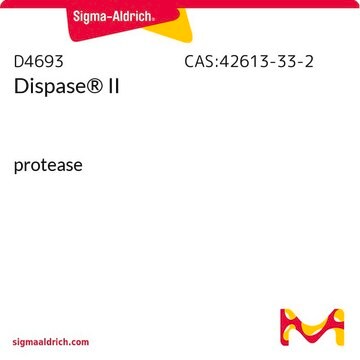The enzyme may be reconstituted at 1 mg/ml in 10 mM sodium acetate buffer, pH 7.5 with 5 mM calcium acetate. Historical data also note that this material may be reconstituted in PBS or other physiologic buffers containing Ca2+, culture medium, or water; however, no concentration is provided.
D4818
Dispase I
protease
Sinonimo/i:
Proteasi
Scegli un formato
About This Item
Prodotti consigliati
Livello qualitativo
Stato
lyophilized solid
Attività specifica
≥10 unit/mg solid
tecniche
cell culture | mammalian: suitable
single cell analysis: suitable
Temperatura di conservazione
2-8°C
Cerchi prodotti simili? Visita Guida al confronto tra prodotti
Applicazioni
Suitable for use in preparation of single cell suspension for sequencing.
Azioni biochim/fisiol
Definizione di unità
Stato fisico
Note legali
Avvertenze
Danger
Indicazioni di pericolo
Consigli di prudenza
Classi di pericolo
Eye Irrit. 2 - Resp. Sens. 1 - Skin Irrit. 2 - STOT SE 3
Organi bersaglio
Respiratory system
Codice della classe di stoccaggio
11 - Combustible Solids
Classe di pericolosità dell'acqua (WGK)
WGK 3
Punto d’infiammabilità (°F)
Not applicable
Punto d’infiammabilità (°C)
Not applicable
Scegli una delle versioni più recenti:
Certificati d'analisi (COA)
Non trovi la versione di tuo interesse?
Se hai bisogno di una versione specifica, puoi cercare il certificato tramite il numero di lotto.
Possiedi già questo prodotto?
I documenti relativi ai prodotti acquistati recentemente sono disponibili nell’Archivio dei documenti.
I clienti hanno visto anche
Articoli
Discover pre-mixed collagenase enzyme blends with DNase I, Dispase II, Elastase, and Hyaluronidase and gently dissociate animal tissues in vitro.
Contenuto correlato
Collagenase Guide.Collagenases, enzymes that break down the native collagen that holds animal tissues together, are made by a variety of microorganisms and by many different animal cells.
-
How to disolve dispase? Can I use mediums as DMEM, PBS ...?
1 answer-
Helpful?
-
-
What is the Department of Transportation shipping information for this product?
1 answer-
Transportation information can be found in Section 14 of the product's (M)SDS.To access the shipping information for this material, use the link on the product detail page for the product.
Helpful?
-
-
What is the solubility of Product D4818, Dispase I?
1 answer-
The enzyme may be reconstituted at 1 mg/ml in 10 mM sodium acetate buffer, pH 7.5 with 5 mM calcium acetate.
Helpful?
-
-
What is the difference between Product D4693, Dispase II and Product D4818, Dispase I?
1 answer-
Product D4693 is a lyophilized powder containing calcium acetate and milk sugar as a stabilizer. The activity specification is >0.5 unit/mg solid. Product D4818 does not contain any milk sugar and has an activity specification of >10 units/mg solid.
Helpful?
-
-
What is the activity of the Product D4818, Dispase, which I received?
1 answer-
Each lot will have a specific activity that can be found on our website on the certificate of analysis.
Helpful?
-
-
At what concentration should Product D4818, Dispase, be used?
1 answer-
To dissociate cells from ECM (extracellular matrix) use at a concentration of 0.6 - 2.4 units/ml.
Helpful?
-
Active Filters
Il team dei nostri ricercatori vanta grande esperienza in tutte le aree della ricerca quali Life Science, scienza dei materiali, sintesi chimica, cromatografia, discipline analitiche, ecc..
Contatta l'Assistenza Tecnica.













